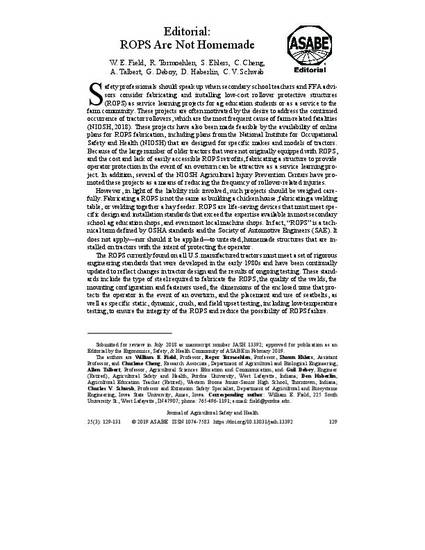
Safety professionals should speak up when secondary school teachers and FFA advisors consider fabricating and installing low-cost rollover protective structures (ROPS) as service learning projects for ag education students or as a service to the farm community. These projects are often motivated by the desire to address the continued occurrence of tractor rollovers, which are the most frequent cause of farm-related fatalities (NIOSH, 2018). These projects have also been made feasible by the availability of online plans for ROPS fabrication, including plans from the National Institute for Occupational Safety and Health (NIOSH) that are designed for specific makes and models of tractors. Because of the large number of older tractors that were not originally equipped with ROPS, and the cost and lack of easily accessible ROPS retrofits, fabricating a structure to provide operator protection in the event of an overturn can be attractive as a service learning project. In addition, several of the NIOSH Agricultural Injury Prevention Centers have promoted these projects as a means of reducing the frequency of rollover-related injuries.
However, in light of the liability risk involved, such projects should be weighed carefully. Fabricating a ROPS is not the same as building a chicken house, fabricating a welding table, or welding together a hay feeder. ROPS are life-saving devices that must meet specific design and installation standards that exceed the expertise available in most secondary school ag education shops, and even most local machine shops. In fact, “ROPS” is a technical term defined by OSHA standards and the Society of Automotive Engineers (SAE). It does not apply—nor should it be applied—to untested, homemade structures that are installed on tractors with the intent of protecting the operator.
Available at: http://works.bepress.com/charles_schwab/138/

This article is published as Field, William E., Roger Tormoehlen, Shawn Ehlers, Charlene Cheng, Allen Talbert, Gail Deboy, Don Haberlin, and Charles V. Schwab. "ROPS are not homemade." Journal of Agricultural Safety and Health 25, no. 3 (2019): 129-131. DOI: 10.13031/jash.13392. Posted with permission.